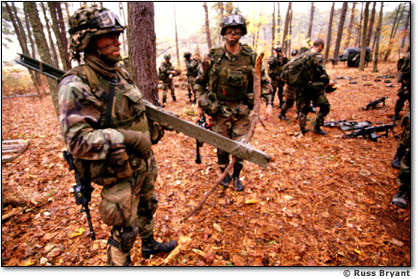Expedient Breaching Charge
Expedient Breaching Charge
Expedient Breaching Charge
Army Rangers have a long history of doing whatever it takes to accomplish their mission. This means being an expert at both conventional and unconventional tactics, and being able to make full use of all equipment in their environment. This is especially evident when it comes to field expedient breaching charges. All Rangers are trained in the use of explosives and demolitions. As the spearhead of any unit going into combat, the Rangers will be the first to encounter obstacles, either minefields, triple apron barbed wire, rolls or razor sharp concertina, or any combination of these. In the past, Army Rangers used the Bangalore Torpedo for clearing a quick path through minefields, and later applied it as an effective breaching charge to create openings through fences, tangle foot, wire obstacles and even walls. The Bangalore was employed at many locations on the beaches of Normandy on D-Day, most memorably depicted in the movie ?Saving Private Ryan?. Although effective, the Bangalore Torpedo proved to be somewhat unwieldy, as each system is comprised of ten 5-foot sections, each section weighing thirteen pounds.
The favored technique by Army Rangers today is to combine C-4 explosive, flex cuffs, electrical tape and steel picket fence lengths into individual breaching sections. The charge can be built in advance for use during a quick and violent assault, such as raiding an enemy camp. As long as the raw materials are available or transported, the charge can also be built enroute the objective or at the final Objective Rallying Point.

By Tim Davis
